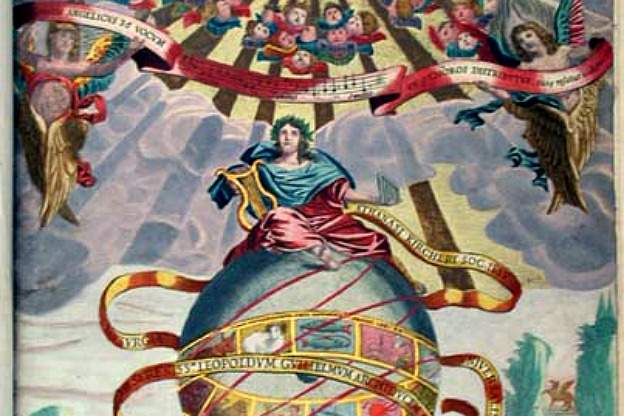
Stylus Phantasticus
The term "stylus phantasticus" or "fantastic style" is one discussed by the 17th-century writer and theorist Athanasius Kircher who said that:
...the fantastic style is suitable for instruments. It is the most free and unrestrained method of composing; it is bound to nothing, neither to words nor to a melodic subject; it was instituted to display genius and to teach the hidden design of harmony and the ingenious composition of harmonic phrases and fugues.
Later, Johann Mattheson also spoke of this style of music in 1739, writing that it was at times:
...now swift, now hesitating, now in one voice, now in many voices, now for a while behind the beat, without measure of sound, but not without the intent to please, to overtake and to astonish.
Two recent recordings are dedicated to music from this time, and in this fantastic style. A 2013 recording called Bach and Before from Chatham Baroque produced on their own label, includes stylus phantasticus sonatas for violin, viola da gamba, theorbo, and organ, including music of Bach, Buxtehude, Biber, Bertali and Schmelzer. Some of the same composers are represented again in a different recording titled Friends of Ferdinand, a 2013 VGO Recordings release from the ensemble Agave Baroque.
Bertali and Schmelzer
Stylus phantasticus flourished in Austria and in particular at the Viennese court, where the Italian-born composer Antonio Bertali lived and worked for most of his life. Both recordings feature works by Bertali, and in them we can hear the musical stylus phantasticus on display-unrestrained, unbounded, and extemporaneous.
Agave Baroque's Aaron Westman played the violin in Bertali's chiacona.
A composer who worked closely with Antonio Bertali at the court of Vienna was Johann Heinrich Schmelzer. Let's listen to Andrew Fouts play some of Schmelzer's sonata quarta from Chatham Baroque's recording.
Biber
Another Austrian colleague active at the time was Heinrich Biber, whose free, rhapsodic writing for the violin in his E major sonata performed by Agave Baroque exemplifies the improvisatory ideal of the fantastic style. Think once more about Mattheson's description while listening to the opening of this Biber sonata: "...now swift, now hesitating, now in one voice, now in many voices, now for a while behind the beat, without measure of sound, but not without the intent to please, to overtake and to astonish."
Biber is a pretty familiar name nowadays, but Agave Baroque also plays some lesser known composers on this disc. One whose name is entirely new to me is Marco Antonio Ferro-a composer and lutenist who also lived and worked in Vienna in the mid-17th century, and one who almost certainly would have crossed paths with Bertali and Schmelzer.Â
Buxtehude
We've been focusing on the stylus phantascius in Austria-Schmelzer and others in Vienna, Biber in Salzburg and so on. But the fantastic style first came to Austria from Italy via the music of Frescobaldi and the practice of virtuosic organ improvisation. And the tradition also spread beyond Austria to Germany in the music of composers like Buxtehude, who was himself an organist well versed in the improvisatory style of keyboard preludes and toccatas.
Chatham Baroque plays one of Buxtehude's sonatas for violin, viola da gamba and continuo on their recording. There is a lively dialog between violin and viol in this piece, and the two instruments intertwine and trade off in easy rhapsody with each other.
Bach
In their liner notes, Chatham Baroque admits that the inclusion of a Bach sonata on this CD might be a little suspect for some and, in many ways, represents the end of the line for pieces in this fantastic style. But like Buxtehude, Bach was an organist and master of the improvisatory style, as evident in his many keyboard works, recognizable as well in his solo violin sonatas and partitas. And so it's not so strange to see one of his sonatas with the other pieces collected on this disc. You can hear the influence of stylus phantasticus predecessors in Bach's music, especially in the slow movements of the G major sonata, and especially in this performance given by Chatham Baroque with that connection in mind.









